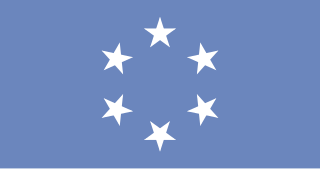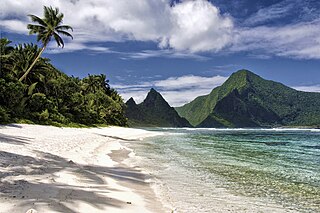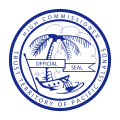
Palau, officially the Republic of Palau, is an island country in the Micronesia subregion of Oceania in the western Pacific. The republic consists of approximately 340 islands and connects the western chain of the Caroline Islands with parts of the Federated States of Micronesia. It has a total area of 466 square kilometers (180 sq mi), making it one of the smallest countries in the world. The most populous island is Koror, home to the country's most populous city of the same name. The capital Ngerulmud is located on the largest island of Babeldaob, in Melekeok State. Palau shares maritime boundaries with international waters to the north, the Federated States of Micronesia to the east, Indonesia to the south, and the Philippines to the northwest.

Palau was initially settled around 1000 BC.

The Trust Territory of the Pacific Islands (TTPI) was a United Nations trust territory in Micronesia administered by the United States from 1947 to 1994. The Imperial Japanese South Seas Mandate had been seized by the US during the Pacific War, as Japan had occupied the territory since the League of Nations gave Japan mandate over the area after World War I. However, in the 1930s, Japan left the League of Nations, and then invaded additional lands. During World War II, military control of the islands was disputed, but by the end of the war the islands had come under control of the Allies. The Trust Territory of the Pacific was created to administer the islands as part of the United States, while still under the auspices of the United Nations. Most of the island groups in the territory became independent states, with some degree of ties kept with the United States: the Federated States of Micronesia, Marshall Islands and Palau are today independent states in a Compact of Free Association with the US, while the Northern Mariana Islands remain under US jurisdiction, as an unincorporated territory and commonwealth.

German New Guinea consisted of the northeastern part of the island of New Guinea and several nearby island groups and was the first part of the German colonial empire. The mainland part of the territory, called Kaiser-Wilhelmsland, became a German protectorate in 1884. Other island groups were added subsequently. The Bismarck Archipelago, and the North Solomon Islands were declared a German protectorate in 1885. The Caroline Islands, Palau, and the Mariana Islands were bought from Spain in 1899. German New Guinea annexed the formerly separate German Protectorate of Marshall Islands, which also included Nauru, in 1906. German Samoa, though part of the German colonial empire, was not part of German New Guinea.

The flag of the Marshall Islands, an island nation in the Pacific, was adopted upon the start of self-government, May 1, 1979. The flag was designed by Emlain Kabua, who served as the first First Lady of the republic.

The Flag of Palau was adopted on 1 January 1981, when the island group separated from the United Nations Trust Territory. As with the flags of several other Pacific island groups, light blue is the color used to represent the ocean and the nation's place within it. While this puts Palau in common with the Federated States of Micronesia and other neighboring island groups, the disc on the flag is off-centre like that of the flag of Bangladesh, but in this case the disc represents the moon instead of the sun. The current flag was introduced in 1981 when Palau became a republic.

In the law of the United States, an insular area is a U.S.-associated jurisdiction that is not part of the several states or the District of Columbia. This includes fourteen U.S. territories administered under U.S. sovereignty, as well as three sovereign states each with a Compact of Free Association with the United States. The term also may be used to refer to the previous status of the Philippines and the Trust Territory of the Pacific Islands when it existed.
This armorial of sovereign states shows the coat of arms, national emblem, or seal for every sovereign state. Although some countries do not have an official national emblem, unofficial emblems which are de facto used as national emblems are also shown below.

The coat of arms of Puerto Rico was first granted by the Spanish Crown on November 8, 1511, making it the oldest heraldic achievement still currently in use in the Americas. The territory was ceded by Spain to the United States in accordance to the peace treaty that ended the Spanish–American War in 1899, after which two interim arms were adopted briefly. A law was passed in 1905 that reestablished the historical armorial bearings as the arms of the territory. Then in 1976, after numerous investigations and amendments, the current version was adopted.

Since 2011, Libya currently does not have an official national emblem. The Constitutional Declaration issued by the National Transitional Council on August 2011 defines the flag of Libya, but does not make any provisions for a coat of arms.

The House of Delegates of Palau is the lower house of the Palau National Congress, Palau's bicameral legislature. The Senate of Palau is the upper house. The House of Delegates has 16 members, each serving four-year terms in single-seat constituencies. Each state represents one constituency. No political parties exist. The last election was held on 3 November 2020.

The coat of arms of Samoa takes its inspiration from the United Nations, as New Zealand administered Western Samoa first as a League of Nations Mandate and then as a United Nations trusteeship until the country received its independence on 1 January 1962, as Western Samoa. Samoa was the first Polynesian nation to reestablish independence in the 20th century. The background is cross-hatched with a grid like the United Nations arms, most of the other elements are duplicated on the national flag.

The German–Spanish Treaty of 1899, signed by the German Empire and the Kingdom of Spain, involved Spain selling the majority of its Pacific possessions not lost in the Spanish–American War to Germany for 25 million pesetas.

The Governor of the South Seas Mandate was an official who administered the South Seas Mandate, a Class C League of Nations mandate in the Pacific Ocean under the administration of the Empire of Japan, as part of the Japanese colonial empire, between 1922 and 1944. The territory consisted of islands awarded to Japan by the League of Nations after World War I, prior to which they had been part of the German colonial empire. During World War II, the United States captured the islands from Japan. After World War II, the United Nations placed the territory under the United States trusteeship as the Trust Territory of the Pacific Islands. The islands are now part of Palau, Northern Mariana Islands, Federated States of Micronesia, and Marshall Islands.
This is a survey of the postage stamps and postal history of the Marshall Islands.

The Congress of Micronesia was a bicameral legislature in Trust Territory of the Pacific Islands from 1964 to 1979.
Palauan nationality law is regulated by the 1980 Constitution of Palau, as amended; the 1994 Palau Citizenship Act, and its revisions; and international agreements entered into by the Palauan government. These laws determine who is, or is eligible to be, a national of Palau. The legal means to acquire nationality, formal legal membership in a nation, differ from the domestic relationship of rights and obligations between a national and the nation, known as citizenship. Palauan nationality is typically obtained either on the principle of jus soli, i.e. by birth in Palau or under the rules of jus sanguinis, i.e. by birth abroad to parents with Palauan nationality. It can be granted to persons with an affiliation to the country through naturalization.





















